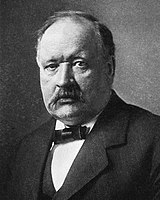
Photo from wikipedia
The flow of nanofluid over a curved Riga surface is a topic of interest in the field of fluid dynamics. A literature survey revealed that the impacts of freezing temperature… Click to show full abstract
The flow of nanofluid over a curved Riga surface is a topic of interest in the field of fluid dynamics. A literature survey revealed that the impacts of freezing temperature and the diameter of nanoparticles on the heat transfer over a curved Riga surface have not been examined so far. Therefore, the flow of nanoparticles, which comprises the influences of freezing temperature and nanoparticle diameter in the energy equation, was modeled over a curved Riga surface. The model was reduced successfully in the nondimensional version by implementing the feasible similarity transformations and effective models of nanofluids. The coupled nonlinear model was then examined numerically and highlighted the impacts of various flow quantities in the flow regimes and heat transfer, with graphical aid. It was examined that nanofluid velocity dropped by increasing the flow parameters γ and S, and an abrupt decrement occurred at the surface of the Riga sheet. The boundary layer region enhances for larger γ. The temperature distribution was enhanced for a more magnetized nanofluid, and the thermal boundary layer increased with a larger R parameter. The volume fraction of the nanoparticles favors the effective density and dynamic viscosity of the nanofluids. A maximum amount of heat transfer at the surface was observed for a more magnetized nanofluid.
Journal Title: Molecules
Year Published: 2020
Link to full text (if available)
Share on Social Media: Sign Up to like & get
recommendations!